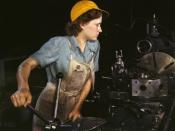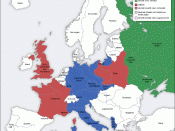Women's lives changed immeasurably both during and after World War 1 in Britain and Germany.
Women's lives in Both Germany and Britain and Germany changed immensly during and after the course of World War 1. Women experienced huge economic, social and political changes, which became the foundation for change for generations of women to come.
Because the majority of men were off fighting in the war, there was a large demand for workers in agriculture, factories, particularly munitions, and offices, and women swiftly took on the vacant positions; they left the house to take up roles traditionally performed by men. Women proved to be just as efficient as men in the workforce, and in some cases, production costs decreased. Employment of women meant that women's roles were no longer in the 'home'. Also, women were earning wages, allowing them to be financially independent, for the first time ever, meaning that many young were able to leave home.
Conditions in Germany were growing desperate, and by the 1920's, eleven million women were employed on the railroads, were hired as guards, worked in coalmines, drove trams and filled banks and insurance companies. While the war did create new employment opportunities for Germany, it also caused great hardship and suffering. The conditions of most fields of work, especially in munitions factories and in the mines, were deemed unhealthy and dangerous. Also, as Germany was affected severely by the Blockade, essential necessities, especially food was in short supply, and many women went to work starving. This resulted in the German women's death rate increasing during the war, with more than sixty-eight women dying during the course of the war. This was also caused by prices rising by four hundred percent, with a major decrease in wages, leaving people dying of poverty.


